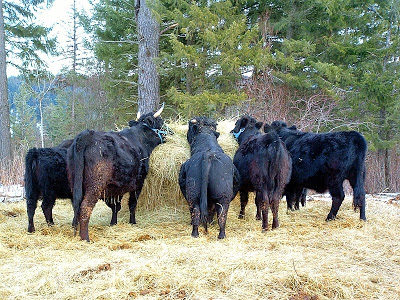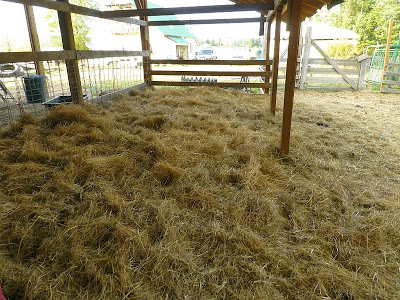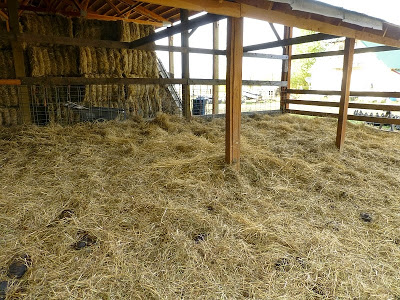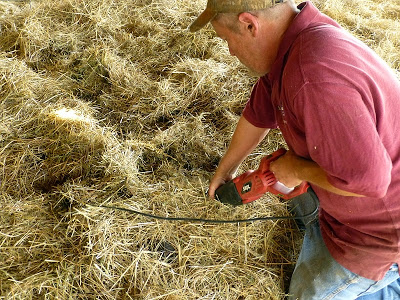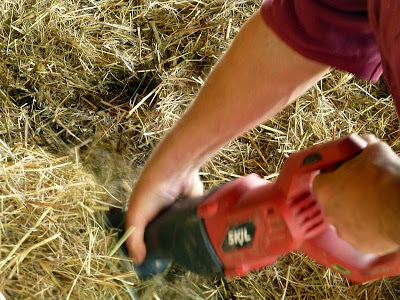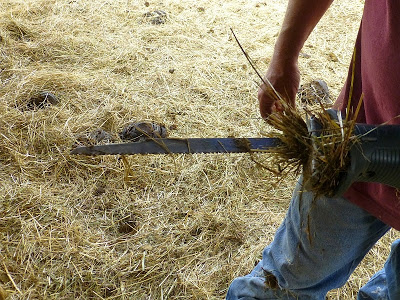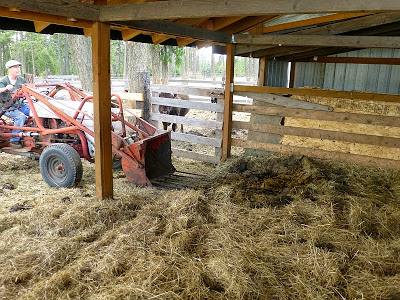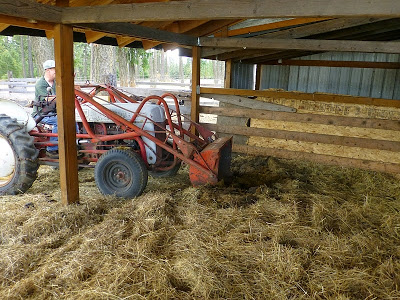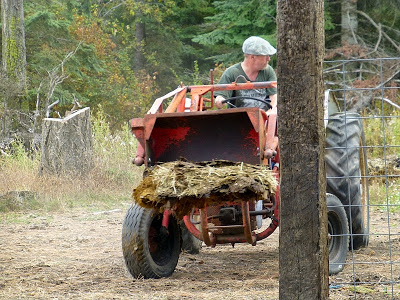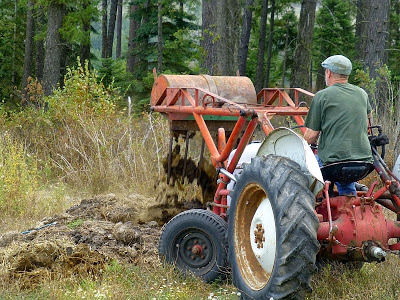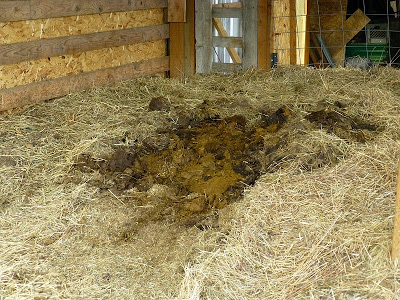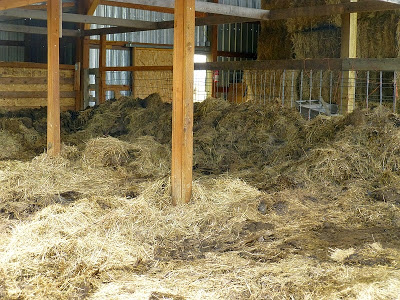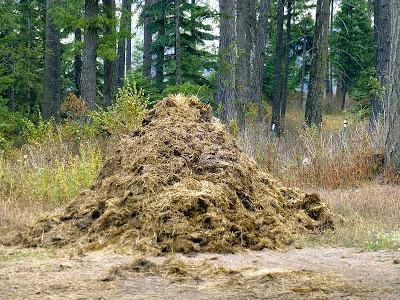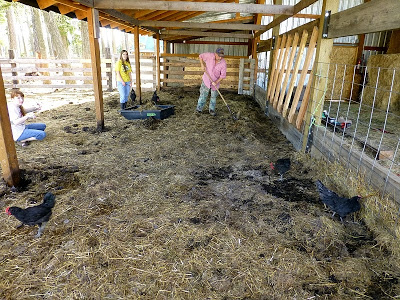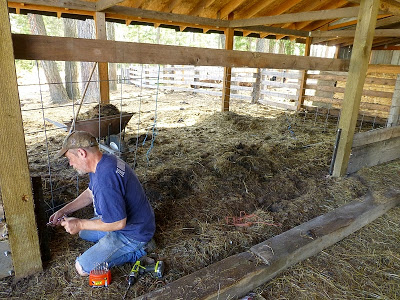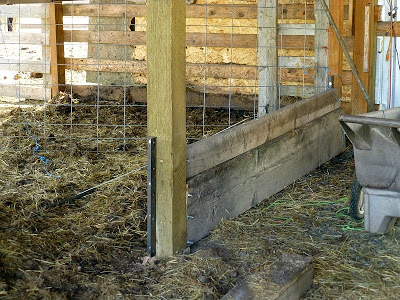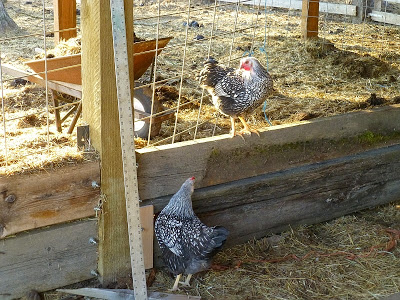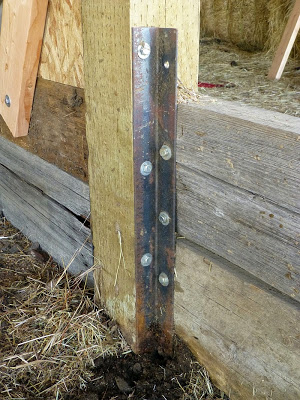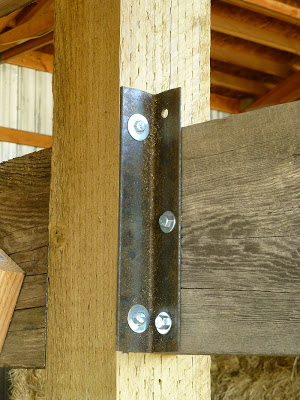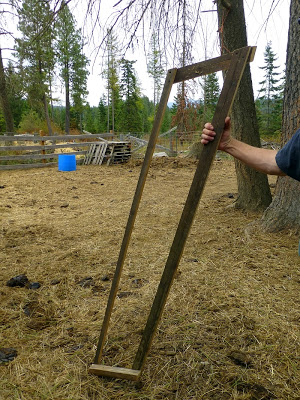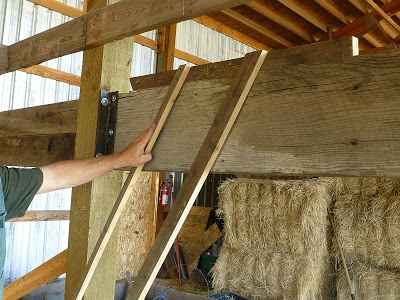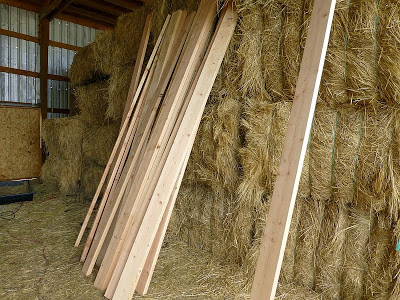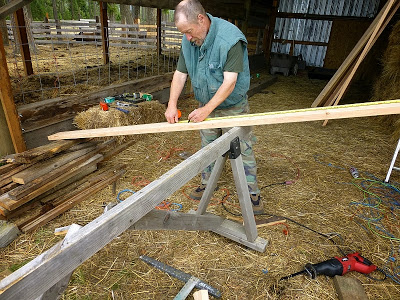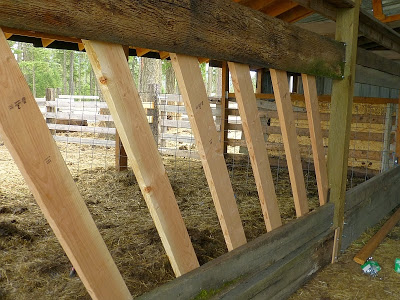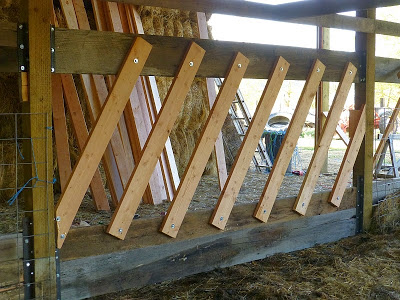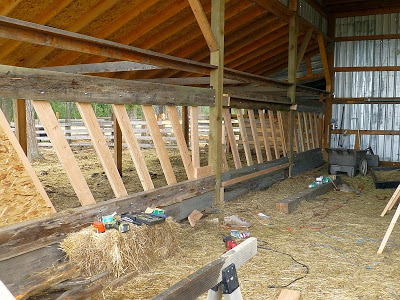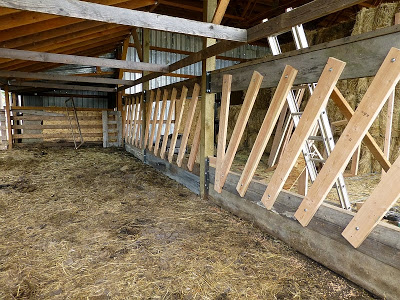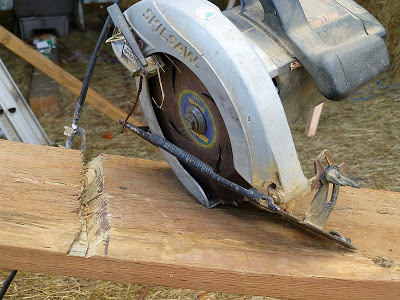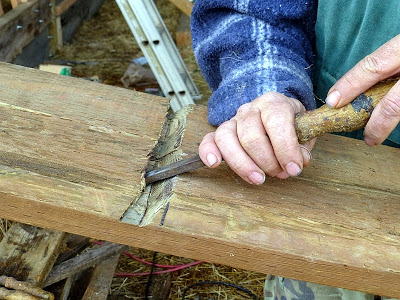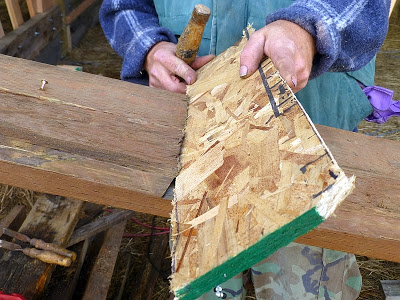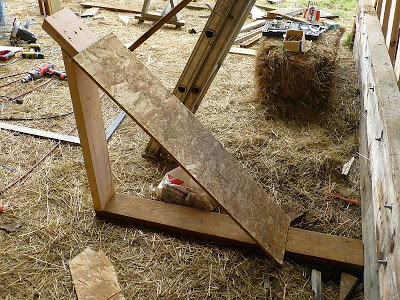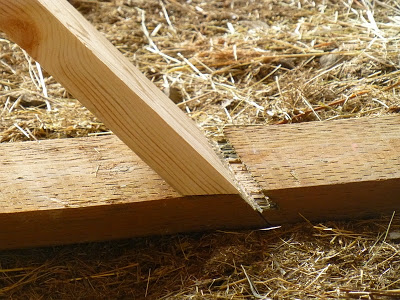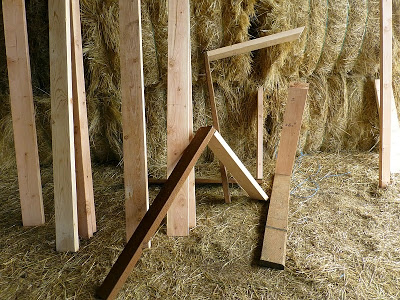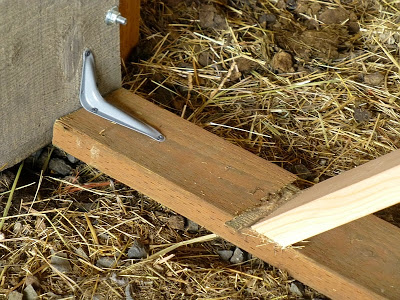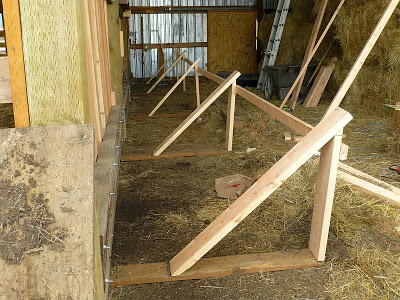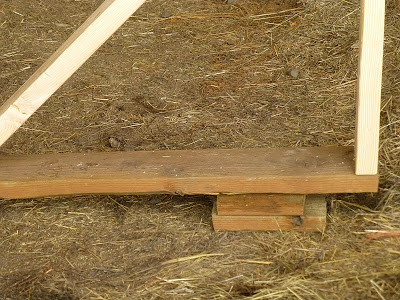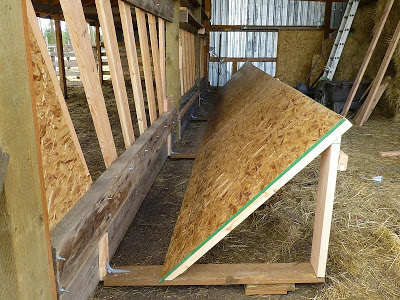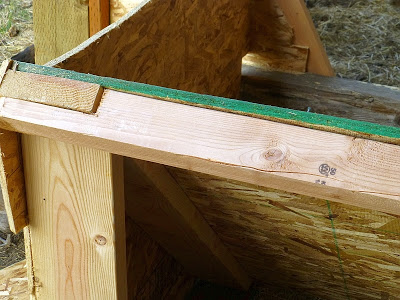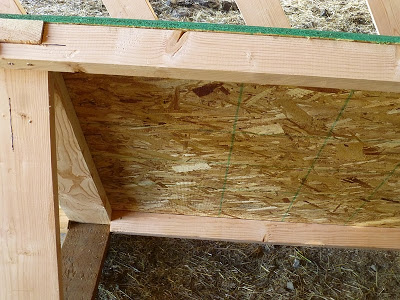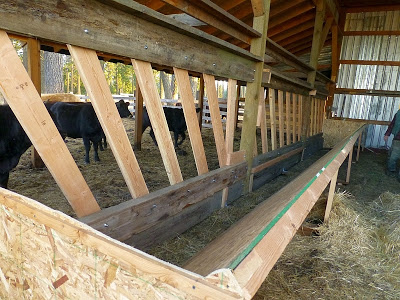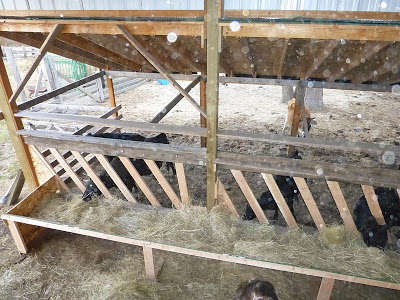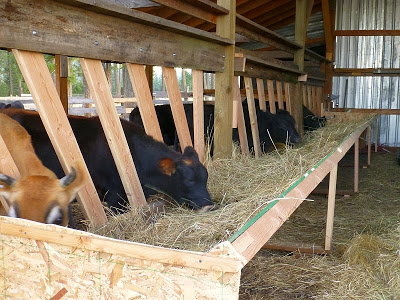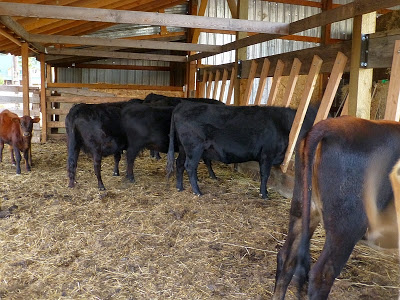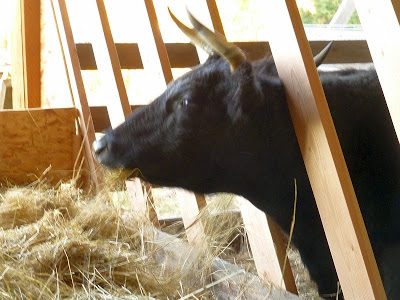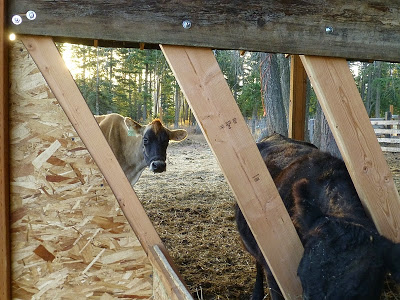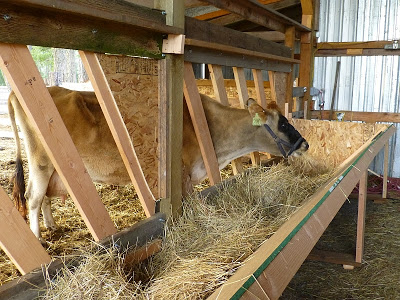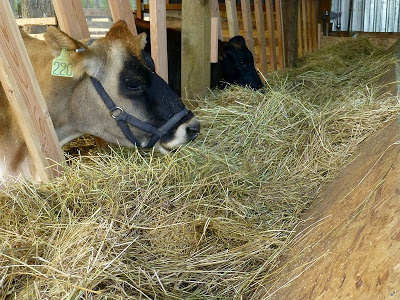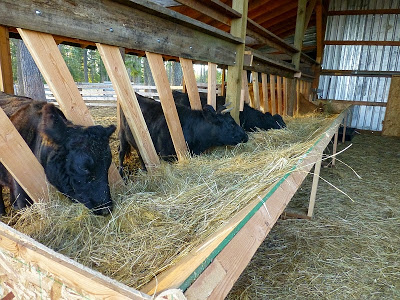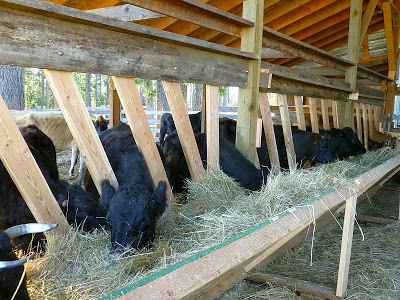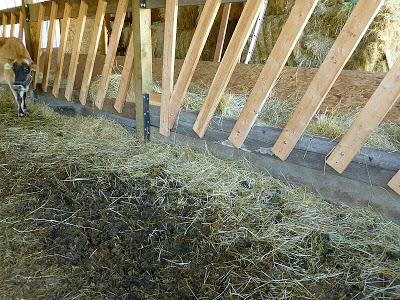| Online: | |
| Visits: | |
| Stories: |

| Story Views | |
| Now: | |
| Last Hour: | |
| Last 24 Hours: | |
| Total: | |
Building feed boxes
Ever since Don built the awning on our barn last year, he’s had another project in mind: to build feed boxes for the livestock.
Before we had the barn built, we fed the cattle in makeshift feed bins that didn’t work well. Dominant animals pushed lower animals out of the way; and hay was wasted like crazy as the animals pulled it out of the boxes and onto the ground where it was trampled and soiled.
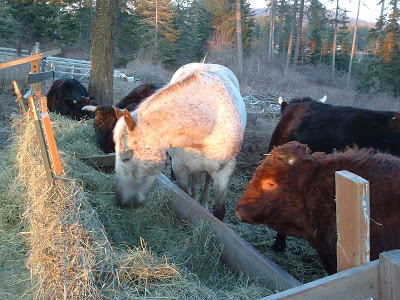
Even worse was back in the days when we simply free-fed. Nothing is better for wasting tremendous amounts of hay. The animals gorge, then they lay in the hay and chew their cud, then stand up and poop and pee all over their food, then they tear into new hay. Baaaaad.
In short, we needed proper feed boxes for maximum efficiency and minimal wastage.
Don had this project in mind as his primary undertaking this fall. But first we had to deal with a few issues.
Since we merely fed over the fence into the awning all last winter, we had a tremendous build-up of compacted hay and manure (yet another testimony to the inefficiency of this method of feeding). Because the awning protects this buildup from weather, the hay was nowhere near composting, which might have made it easier to remove.
It was a surprisingly complex issue of how to get that compacted hay out from under the awning. Sure we could pitchfork it wheelbarrow by wheelbarrow out to the compost pile, but that would take, literally, weeks. A tractor bucket was useless because the bucket couldn’t “stab” the mats in order to lift it out — it merely pushed it more because it was one gigantic mat 36 feet across and twelve feet wide.
What needed to happen was to get the matted hay cut into smaller, more manageable (and “liftable”) pieces so they could be lifted with a tractor. So what did my brilliant husband do? He used a saws-all!
Yes, he literally cut the mat of hay/manure into pieces. He admits it was an experiment, but boy howdy did it work beautifully.
He used his beefiest blade and had to stop and clean it off every so often, but he sawed his way through the entire matted area beneath the awning in blocks about three feet square. Love this guy. He’s so durn smart.
The loosened mats allowed him to hitch up the manure bucket on our old tractor, and “stab” the hay out. (An old-fashioned manure bucket has prongs on the bucket.)
He deposited the matted hay and manure onto a pile at the edge of the woods. Now it can start composting.
This is what the project looked like near the beginning.
And this is what it looked like at the end, when he could no longer use the tractor because the bucket was “pushing” rather than “scooping.”
This is the resulting compost pile. Impressive, no?
After this, it was hand-work — pitching the manure into a wheelbarrow and trundling it to the compost pile. Fortunately the stuff was so loosened up by this point that it wasn’t hard, just time-consuming. He roped the girls in as well (he pitched, they trundled).
Once the bulk of the matted hay/manure was out of the way, the next step was to install stout boards across the base of the awning. These boards will support the feed box slats and keep the hay from falling through.
Naturally the chickens thought all the disruptions (which revealed loads of worms) were strictly for their benefit.
The boards were bolted to angle iron braces. He later screwed a piece of wood at the exposed top of each brace so the animals wouldn’t stab or scrape themselves on the sharp corner of the iron.
Don also installed boards four feet above the ground to hold the upper part of the slats.
Then came a critical part — the slats through which the cattle would put their heads to eat from the feed boxes. Don did all kinds of research on how wide the slats should be and concluded the best distance was 13inches (horizontally). To make sure the slats were identical across the width the barn, he built a jig.
When laid across the top and bottom boards, he could mark where the slats should go.
He bought some 2×6′s…
…cut them to the correct length…
…and bolted them top and bottom to the stout boards.
Before installing the slats the entire width of the barn , we tested them out on a few critters to see if they were too wide or too narrow. Perfect fit.
Encouraged, he installed slats across the whole width of the barn under the awning.
Then it was time to build the feed boxes themselves. A critical part is the angled backside that will hold hay. To brace these at the bottom, Don first cut, then chiseled, slots at a 45 degree angle on pressure-treated boards.
This will brace the OSB sheets so they won’t slide around.
Then he built a series of triangular brackets (with the chiseled pressure-treated boards at the bottom) to support the feed box backs.
The base of the triangle rests right in front of the angled groove.
Here’s some more brackets, half-made.
He bracketed the triangle to the baseboard.
Brackets, loosely set up.
Where necessary, he braced up the brackets where the ground is uneven. Eventually we’ll pour concrete footers for permanent bases.
Then we slid sheets of OSB into place, braced at the bottom by the chiseled grooves. OSB has a rough side and a “shiny” side. We put the shiny side facing up so hay could slide down it more easily.
Don braced the OSB at top and bottom, making it solid as a rock.
Then he built end-caps. The cap at the far is is removable so we can walk into the feed boxes if necessary.
View from above.
We had no idea how the cattle would handle the slatted feed boxes. None of them had ever seen one before, with the possible exception of Matilda who came from a commercial dairy.
Well oh my, after a few bewildered minutes they took to it like a duck to water.
Despite all the research and effort Don put into these feed boxes, we had no way of knowing how well they would work. There were intangible aspects to consider, most notably the pecking order of the cattle and how much they would jostle each other.
We’ve learned a few valuable things. For example, our dominant herd matriarch, Jet, has horns and isn’t afraid to use them against lesser cattle. My concern was she would walk around and stab beasties in the butt while they were trying to eat.
In fact the opposite has occurred. It’s a bit more difficult for Jet to negotiate her horns between the slats, so once she’s there, she stays there. While occupied, other animals can eat without worrying about her. When she pulls her head out, many of the other animals pull their heads out as well, to keep a wary eye on her. So the incidences of aggression and dominance have dwindled.
In fact they’ve dwindled so much that we may keep Jet longer than planned. Earlier this year we made the difficult decision to butcher our other herd matriarch, Ruby, because she was so aggressive to other animals. We were considering the same fate for Jet if she proved too ornery with the feed boxes. Now it doesn’t look like it will be necessary.
Another advantage is the less dominant animals eat better. Before this, when we were just tossing hay over the fence onto the ground, the dominant animals would eat what they wanted, and more often than not lay down, and later urinate or defecate, on whatever was left over. Less dominant animals had to pick their way around the soiled hay.
Most animals managed okay, but I always fed Matilda separately. Poor Matilda is bottom on the totem pole, so I often spoiled her by putting her in a separate pen at night with a nice pile of hay just for herself, to make sure she got enough to eat.
Now Matilda still hangs back, letting the dominant animals eat first…
…but then she can come in later and eat as much as she wants. There’s more food because nothing is getting spoiled by being trampled on.
It seems almost as if the feed boxes have had a “civilizing” effect on the cattle. They no longer make a mad feeding-frenzy trample for the food at feeding time — they politely (well, mostly) jockey for position and quietly eat. They can eat throughout the day, not just mornings and evenings, since there’s almost always something available to snack on. Currently there are twelve animals (including the calves) with access to the feed boxes, and we’ve seen as many as ten at a time eating — with good manners!
The amount of wasted hay is staggeringly decreased. After FIVE DAYS of using the feed boxes, this is all that got tossed on the ground:
The hay that remains in the feed boxes doesn’t get wet, doesn’t get trampled, doesn’t get soiled, and doesn’t get compressed. It remains fresh and good for the animals to eat throughout the day. And I actually do a little happy dance when a cow starts to urinate while eating — because she’s not fouling her food!
One thing Don did throughout the construction process was make everything replaceable. Over the years of owning cattle, we’ve learned the hard way how rough they can be on infrastructure. By making the parts of the feed boxes replaceable, if a board or sheet of OSB or slat gets damaged, he can replace it without a great deal of trouble.
We simply cannot get over how wonderful these feed boxes are. Frequently we’ll wander over and just watch the animals eat, big grins on our faces. They are a 110% success!!
Source: http://www.rural-revolution.com/2014/10/building-feed-boxes.html




